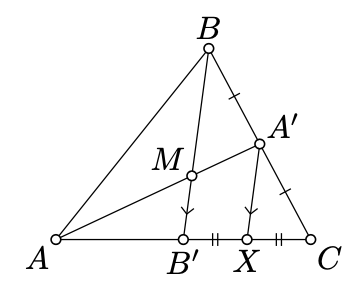8.3: Medians and centroid
- Page ID
- 23628
A median of a triangle is the segment joining a vertex to the midpoint of the opposing side.
The three medians of any nondegenerate triangle intersect in a single point. Moreover, the point of intersection divides each median in the ratio 2:1.
The point of intersection of medians is called the centroid of the tri- angle; it is usually denoted by M. In the proof we will apply Exercise 3.4.3 and Exercise7.3.1; their complete solutions are given in the hits.
- Proof
-
Consider a nondegenerate triangle \(ABC\). Let \([AA']\) and \([BB']\) be its medians. According to Exercise 3.4.3, \([AA']\) and \([BB']\) have a point of intersection; denote it by \(M\).

Draw a line \(\ell\) thru \(A'\) parallel to \((BB')\). Applying Exercise7.3.1 for \(\triangle BB'C\) and \(\ell\), we get that \(\ell\) cross \([B'C]\) at some point \(X\) and
\(\dfrac{CX}{CB'} = \dfrac{CA'}{CB} = \dfrac{1}{2};\)
that is, \(X\) is the midpoint of \([CB']\).
Since \(B'\) is the midpoint of \([AC]\) and \(X\) is the midpoint of \([B'C]\), we get that
\(\dfrac{AB'}{AX} = \dfrac{2}{3}.\)
Applying Exercise 7.3.1 for \(\triangle XA'A\) and the line \((BB')\), we get that
\[\dfrac{AM}{AA'} = \dfrac{AB'}{AX} = \dfrac{2}{3};\]
that is, \(M\) divides \([AA']\) in the ratio 2:1.
Note that 8.3.1 uniquely defines \(M\) on \([AA']\). Repeating the same argument for medians \([AA']\) and \([CC']\), we get that they intersect at \(M\) as well, hence the result.
Let \(\square ABCD\) be a nondegenerate quadrangle and \(X, Y, V, W\) be the midpoints of its sides \([AB], [BC], [CD]\), and \([DA]\). Show that \(\square XYVW\) is a parallelogram.
- Hint
-
Use the idea from the proof of Theorem \(\PageIndex{1}\) to show that \((XY) \parallel (AC) \parallel (VW)\) and \((XV) \parallel (BD) \parallel (YW)\).


